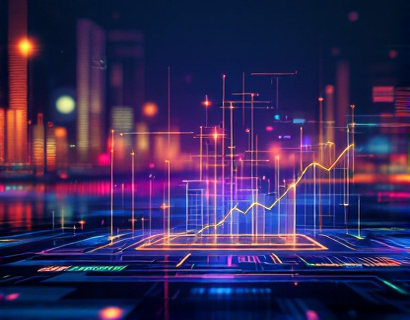Unlocking Financial Transformations: Harnessing AI and Crypto for Next-Gen Innovations
The intersection of artificial intelligence and cryptocurrency is giving birth to a new era of financial and technological innovation. This fusion is not just a trend but a fundamental shift in how we perceive and interact with digital finance. The integration of AI and crypto is redefining traditional financial systems, creating more efficient, secure, and user-friendly solutions. This article delves into the transformative impact of this merger, exploring how it is setting new industry standards and enhancing user experiences.
The traditional financial sector has long been characterized by its complexity, rigidity, and sometimes, opacity. The entry of AI and cryptocurrency into this domain is disrupting these norms. AI brings intelligence, automation, and predictive capabilities, while cryptocurrency offers decentralization, transparency, and security. Together, they are paving the way for next-generation financial innovations that are more accessible, efficient, and empowering for users.
Enhanced Security and Fraud Detection
One of the most significant benefits of combining AI and cryptocurrency is the enhancement of security measures. Traditional banking systems rely heavily on centralized databases, making them prime targets for cyberattacks. In contrast, blockchain technology, the backbone of cryptocurrency, provides a decentralized and immutable ledger. When AI is integrated into this system, it significantly boosts security through advanced fraud detection algorithms.
AI can analyze vast amounts of data in real-time, identifying patterns and anomalies that indicate potential fraud. Machine learning models can adapt and improve over time, making them highly effective against evolving threats. This level of security is crucial in a digital finance landscape where data breaches and cybercrime are increasingly common. By leveraging AI, crypto platforms can offer users a safer and more trustworthy environment for transactions and asset management.
Streamlined KYC and Anti-Money Laundering Processes
Know Your Customer (KYC) and Anti-Money Laundering (AML) processes are essential for regulatory compliance but can be cumbersome and time-consuming. AI-driven solutions are revolutionizing these processes by automating and optimizing them. AI algorithms can quickly verify user identities, cross-reference data from multiple sources, and flag suspicious activities with high accuracy.
This not only speeds up the onboarding process for users but also ensures that financial institutions meet regulatory requirements more efficiently. The use of AI in KYC and AML reduces the risk of human error and enhances the overall integrity of the financial system. As a result, users experience a smoother and more secure onboarding process, fostering greater trust and adoption of crypto services.
Personalized Financial Services
AI's ability to analyze and interpret large datasets makes it an ideal tool for personalization in financial services. By understanding user behavior, preferences, and financial goals, AI can provide tailored recommendations and solutions. In the context of cryptocurrency, this means offering personalized investment strategies, portfolio management, and financial planning tools.
For instance, AI-powered bots can monitor market trends and automatically execute trades based on predefined criteria, helping users maximize their returns. Additionally, AI can analyze a user's spending habits and suggest ways to save or invest more effectively. This level of personalization not only enhances the user experience but also democratizes access to sophisticated financial tools, making them available to a broader audience.
Decentralized Finance (DeFi) and AI
Decentralized Finance (DeFi) is a rapidly growing sector that aims to create financial systems without central intermediaries. AI plays a crucial role in enhancing the functionality and efficiency of DeFi platforms. Smart contracts, which are self-executing contracts with the terms directly written into code, can be optimized using AI to improve their performance and security.
AI can also help in risk assessment and management within DeFi. By analyzing historical data and real-time market conditions, AI models can predict potential risks and suggest mitigation strategies. This is particularly important in a decentralized environment where traditional regulatory oversight is limited. Users benefit from a more robust and reliable DeFi ecosystem, reducing the likelihood of losses due to smart contract vulnerabilities or market fluctuations.
Tokenization and AI-Driven Asset Management
Tokenization, the process of converting assets into digital tokens on a blockchain, is another area where AI and crypto intersect. Tokenization enables fractional ownership, increased liquidity, and greater accessibility to a wide range of assets, from real estate to art. AI enhances this process by providing sophisticated asset management tools.
AI algorithms can analyze market data, economic indicators, and other relevant factors to optimize token pricing and trading strategies. Robust predictive models can forecast asset performance, helping investors make informed decisions. Moreover, AI can automate the management of tokenized assets, ensuring that investments align with user-defined goals and risk profiles. This combination of tokenization and AI-driven analytics offers a new paradigm in asset management, making it more dynamic and responsive to market changes.
User Experience and Interface Innovations
The user experience (UX) is a critical factor in the adoption and success of any financial technology. AI and crypto are transforming UX design in ways that were previously unimaginable. Intelligent interfaces powered by AI can adapt to user preferences, providing a seamless and intuitive experience. Voice-activated assistants and chatbots, driven by natural language processing (NLP), make interacting with financial services more natural and accessible.
For example, AI-powered chatbots can guide users through complex financial processes, answer queries, and provide real-time support. These bots can operate 24/7, ensuring that users receive assistance whenever they need it. Additionally, AI can analyze user interactions and feedback to continuously improve the interface, making it more user-friendly and efficient. This focus on UX innovation is essential for building user trust and driving adoption in the crypto space.
Market Prediction and Trading Bots
One of the most exciting applications of AI in the crypto space is the development of market prediction and trading bots. These bots use advanced algorithms to analyze vast amounts of data, including historical price movements, news sentiment, and technical indicators, to make informed trading decisions. AI's ability to process and interpret complex data sets in real-time gives these bots a significant edge over traditional trading methods.
Trading bots can execute trades automatically based on predefined strategies, reducing the emotional bias that often affects human traders. This not only increases the potential for higher returns but also minimizes the risk of losses. For individual investors, these bots democratize access to professional-level trading tools, leveling the playing field in the often volatile crypto markets. As AI continues to evolve, the accuracy and effectiveness of these bots are likely to improve, further enhancing their value to users.
Cross-Chain Interoperability and AI
Interoperability between different blockchain networks is a key challenge in the crypto ecosystem. AI is playing a pivotal role in addressing this issue by developing solutions that enable seamless communication and data exchange between disparate chains. AI algorithms can optimize cross-chain transactions, ensuring they are secure, efficient, and cost-effective.
For instance, AI can manage the complex process of atomic swaps, where two parties exchange assets directly without the need for a central intermediary. By analyzing network conditions, transaction fees, and other variables, AI can determine the optimal time and method for these swaps, enhancing the overall user experience. This level of interoperability is crucial for the growth of a unified and interconnected crypto market, where users can seamlessly interact with various platforms and assets.
Regulatory Compliance and AI
As the crypto space continues to expand, regulatory compliance becomes increasingly important. AI can assist in navigating the complex landscape of global regulations by providing real-time updates and ensuring adherence to local laws. AI-driven compliance tools can monitor transactions, identify potential regulatory issues, and generate reports to demonstrate compliance.
These tools can help crypto platforms stay ahead of regulatory changes, reducing the risk of penalties and enhancing their reputation. For users, this means a more secure and compliant environment, fostering greater confidence in crypto services. AI's role in regulatory compliance is essential for the sustainable growth of the crypto industry, ensuring that innovation does not outpace legal frameworks.
Conclusion
The fusion of AI and cryptocurrency is unlocking a new era of financial transformations. By enhancing security, streamlining processes, personalizing services, and innovating user experiences, this merger is setting new industry standards. As AI continues to evolve, its potential to revolutionize the crypto space is immense, offering endless possibilities for next-generation financial solutions. The future of finance is intelligent, decentralized, and empowering, thanks to the synergy between AI and cryptocurrency.











































